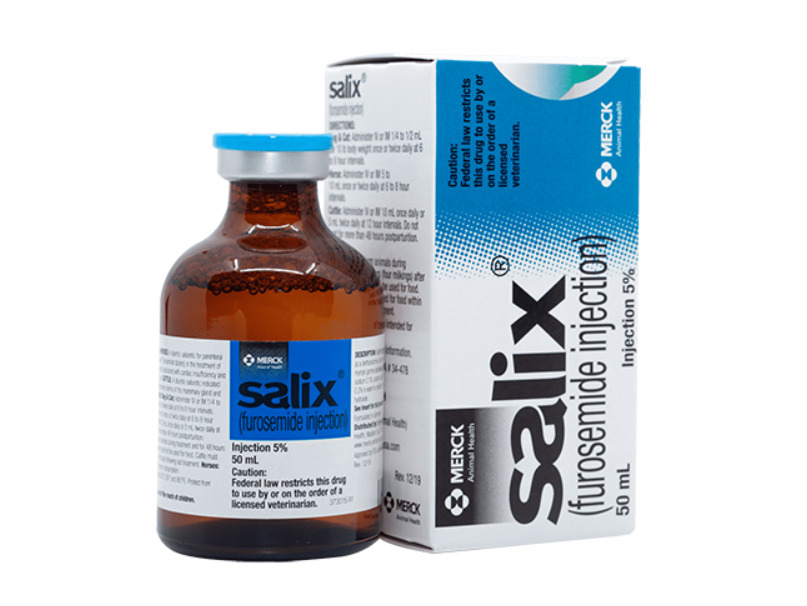For decades now, people with an interest in horse racing have had opinions about furosemide, commonly referred to by its trade name of Lasix or Salix.
Even now, as its use has been gradually pushed back farther from race time, theories abound on why trainers use it, and how (or whether) it should be used.

But floating about amongst all those opinions are sometimes misconceptions, including one we’ve heard repeatedly at the Paulick Report – that furosemide is used as a masking agent to cover up illegal drug use in post-race testing.
The internationally acknowledged Pualick Reports states that Dr. Rick Sams, former laboratory director at LGC Science, said that under current regulations, that just isn’t possible.
Here’s why.
To understand how furosemide does its work you need to understand the basics of the kidney. Kidneys are responsible for filtering the blood that travels through the body and sending some elements out to the bladder for excretion through the urine.
As part of this process, blood encounters a membrane called a glomerulus, which has large pores. The pores allow small things like electrolytes, drugs and their metabolites to pass through it; larger things like proteins and red blood cells get caught in the filter and are sent back through the body. Small things may (or may not) get sent through a tubule and become part of the horse’s urine.
A few different factors determine how a molecule is directed – and this is where the biology gets interesting from a drug testing standpoint. Ever wonder why we take both blood and urine from a racehorse after a race? It’s because different drug molecules (or drug metabolite molecules) have different chemical properties that guide how the glomerulus reacts to them. Some of them mix well with water while others don’t; most carry varying degrees of chemical charge (ionization), depending upon their makeup.
Highly ionized drugs readily cross the glomerulus but those molecules aren’t reabsorbed into the body along with water because they are too polar. More of them end up in the urine than return to the body, which means drugs that have a high ionic charge will probably have higher concentration in urine than in blood if you test a horse after administration.
Other drugs that pass through the filter end up split pretty evenly between reabsorption from the filtrate into the bloodstream and going out into urine, so if you test the horse for one of those substances you may find a similar concentration in each medium. Still others may bind to plasma proteins, making them less likely to be filtered so a post-race drug test would find that drug in much higher concentrations in blood than in urine.
What has this got to do with furosemide?
Furosemide does its work by creating a rapid diuresis, or flushing of water from the body, after administration. Its impact is quicker after intravenous administration, but its effect is shorter; intramuscular administration produces a slower onset and slower diminishment, but for either administration we’re talking about a matter of just a few hours after administration.
Once the furosemide ends up in the horse’s blood and passes through the glomerulus, it binds to chloride transporters in the renal tubules. Suddenly less chloride is reabsorbed from the tubules, and that triggers a flushing out of fluid from the renal tubules, increasing the volume of urine the horse produces.
While that horse is suddenly sending a lot more water into the bladder, its urine is becoming very dilute. Dr. Sams said some drugs and their metabolites may be found at concentrations 50 to 200 fold less during peak diuresis than they would have been in urine produced under normal conditions.
“I remember testing those samples in the late 1970s, early 1980s, and the samples we received looked like water,” he said. “There was no color whatsoever.”
Furosemide has a short half-life though. Horses will begin urinating within minutes of administration, with peak diuresis coming at 15-30 minutes after administration. The total diuretic effect lasts for about two to two and a half hours. By the end of that, the urine has become more concentrated and is nearly back to normal.
Of course, the disruption of the usual urine formation process has a ripple effect – some drugs that would have normally been reabsorbed into the bloodstream may not be as extensively reabsorbed during diuresis because there is no “driving force” for reabsorption from dilute urine. This can mean they are excreted in the dilute urine when under normal circumstances, they would be reabsorbed and remain in the body longer.
So furosemide may be an effective masking agent, but only for some drugs, right?
Not quite so fast.
In those wild early days of furosemide use, Sams said there was very little guidance to veterinarians about how much of the drug a veterinarian should give a horse and when if they were trying to prevent EIPH. In the beginning of its use in horses, the drug wasn’t Food and Drug Administration-approved to treat that condition in horses, and so the drug company couldn’t legally offer advice on how to give it to a species it wasn’t approved for. Some veterinarians gave horses 500 milligrams in a dose, while others gave 250 milligrams. Some did intramuscular shots while others did intravenous, and still others did a combination.
“Veterinarians were just using whatever dose they thought worked best,” he said. “Some of them thought more would be better than less.”
In the very beginning, pre-race administration wasn’t regulated the way it was now. Treating veterinarians could give the drug themselves (while now many states require it to be given by a third-party veterinarian) and they could give it whenever they liked, as long as it was pre-race. Sams remembers some practitioners sticking furosemide needles in horses in the paddock.
As drug regulation evolved, its use became more standardized. The 250 mg dose became standard over the 500 mg dose.
Sams remembers that at one point you could give that dose two hours pre-race.
Four hours was the standard for many years. That window, Sams said, was enough that the drug, when given as directed, would be finished with its flushing effect.
The horse’s body is designed to regain balance pretty quickly, so once that initial diuresis is complete, Sams said the kidneys go back to behaving the way they did before – and urine concentration goes back to normal quickly, too. The minor amount of dilution happening at four hours isn’t enough to hide drugs from modern testing methods, according to Sams.
Within the past several years, several states made moves to push back furosemide administration even farther, to 24 hours pre-race. By that timeframe, Sams said any dilution effect is certainly gone.
“I don’t hear laboratory personnel bemoaning the fact that furosemide is interfering with their ability to detect other substances,” he said. “That went away with the regulation that began being used in the mid-1980s.”
So does that mean it’s not a performance-enhancer?
Sams can’t go that far. Peer-reviewed research has shown, convincingly in his view, that horses treated with furosemide do exhibit improved performance over those who don’t, but that’s probably due at least partly to the weight loss that comes with fluid loss during diuresis.
Of course, races in which all horses are getting furosemide at the same time in the same manner could presumably be level playing fields where all runners have roughly similar advantages over non-treated runners.
So, do pre-race electrolyte jugs do anything?
If you’ve read about oral supplementation of electrolytes as a means of getting horses to drink more water, you know that there’s some debate about whether it works to actually change the salt/water balance in a horse’s body. With all the flushing out happening in a horse who’s just been given furosemide, is adding those elements in an electrolyte jug given the day before a race really going to help?
“It’s a prudent thing to do,” said Sams. “The kidneys maintain homeostasis of the electrolytes quite well, so if you give an excess in that jug, they’ll just go out in the urine. And homeostasis will be restored by the electrolytes in the jug.”

And then there’s TCO2
Sams said there’s an important impact on furosemide that doesn’t get talked about a lot – the results of TCO2 testing.
When furosemide binds to binds to the chloride ion transporter, more sodium and potassium ions are excreted in the urine. That’s because sodium and potassium are positively-charged and would normally pair up with negatively charged chloride ion. The other positively-charged ion that would normally be hanging around, binding to chloride to offset its negative charge, is a hydrogen ion. When furosemide increases chloride ion excretion some hydrogen ions are also eliminated in the urine as a means of maintaining electrical neutrality.
That means the pH of the blood increases a little bit. This pH increase is attributed “metabolic alkalosis” and in the drug testing world, it can confuse things.
“From a physiologic point of view, the effect is identical to giving sodium bicarbonate,” said Sams. “So the administration of furosemide to a horse creates a state of metabolic alkalosis that is dose-dependent … furosemide administration can give rise to an increase in pH, an increase in total carbon dioxide (TCO2) that looks like milkshaking.
“I’m convinced that some of the laboratory reports for excess TCO2 are not due to the administration of sodium bicarbonate but due to the administration of furosemide.”
This effect could vary by dosage or by individual, but we don’t know exactly how.
When analyzing a sample, Sams prefers to match the TCO2 sample with data showing that horse’s sodium and potassium concentrations in the blood. If the result came from milkshaking, sodium will be significantly higher than normal; if it didn’t, sodium should be normal and the chloride is low.
Unfortunately, Sams said, testing protocols aren’t uniform on this. When international drug testing standards were developed abroad for TCO2, they didn’t call for a look at these ions, because in other countries furosemide use isn’t taking place as close to a race.

What about the calcium connection?
Those looking for a simple explanation for fatal raceday orthopedic injuries may have perked up at the mention of furosemide inhibiting reabsorption of chloride ions, flushing out positive ions like sodium and potassium. Calcium is also positively-charged, and some human research suggests that furosemide can impact bone health because of its tendency to affect calcium.
Sams cautious against appropriating those human studies to horses, however.
The human studies were done on an aging population which is therefore 1) more prone than the average person to bone health issues and is also 2) likely to be taking the drug every day, sometimes multiple times a day. Horses aren’t being exposed to it as often, which makes sense because humans taking it are usually trying to treat a chronic issue like high blood pressure.
“In those patients, electrolyte imbalances can occur,” he said. “And it has some long-term effects on bone metabolism. But who are the persons who are getting furosemide treatment? They’re usually older people who may be frail or debilitated anyway.
“I haven’t seen any evidence for effects of infrequent, periodic use in horses. And those are healthy horses.”
So, where does this leave us?
It’s probably true that furosemide, given in its modern form, isn’t helping anyone hide significant drug use, and it isn’t likely causing long-term damage to a horse’s bone formation. It seems likely that under the Horseracing Integrity and Safety Authority, its administration could be backed up farther from the standard four hours pre-race that many states are used to now. It remains to be seen whether the drug will accomplish its purpose – reducing EIPH – with a longer withdrawal timeframe.
- www.paulickreport.com









